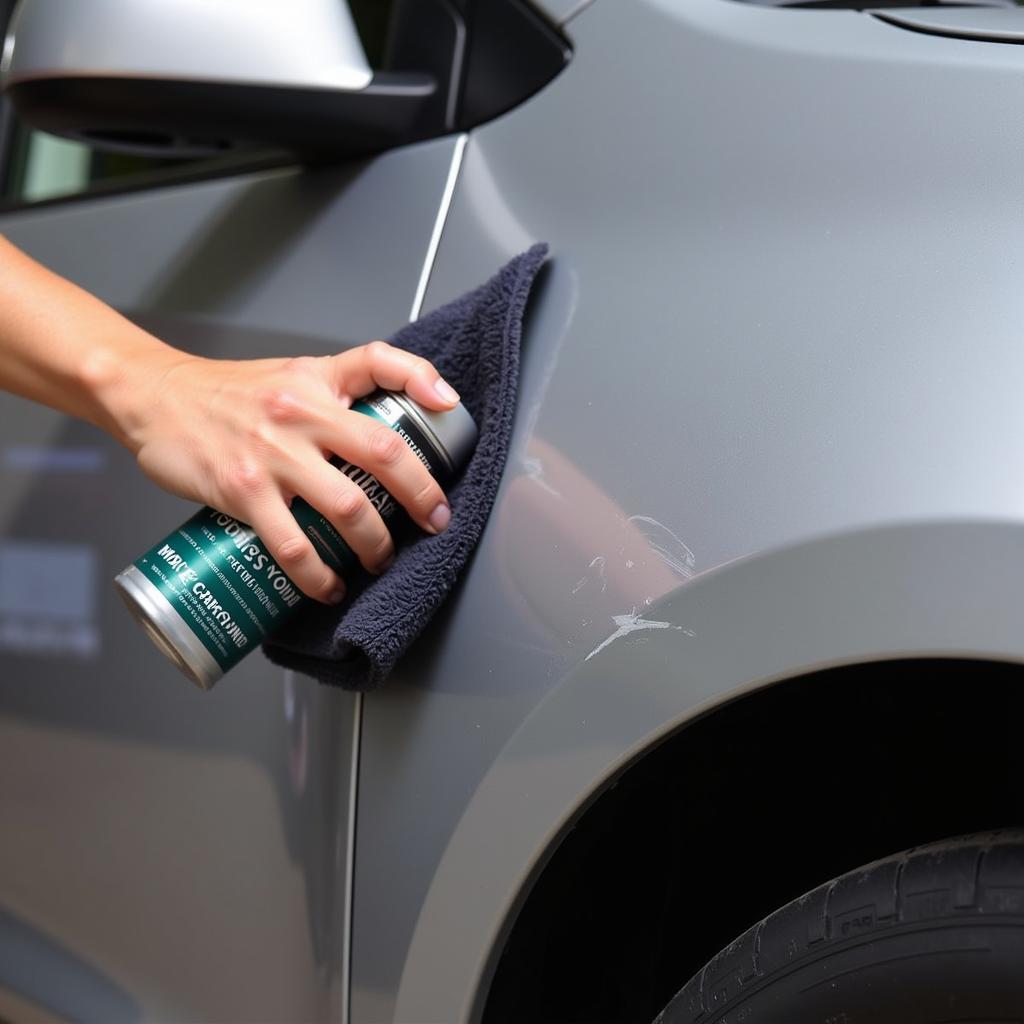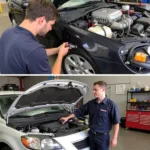Dealing with paint scrapes on your car can be frustrating. Whether it’s a minor scratch from a rogue shopping cart or a more significant scrape from a parking lot mishap, knowing how to repair paint scrapes on car can save you time and money. This guide will walk you through the process, from assessing the damage to achieving a professional-looking finish.
Fixing a paint scrape doesn’t always require a trip to the body shop. With the right tools and techniques, you can often repair minor scrapes yourself. We’ll cover everything from simple touch-up paint applications to more involved repairs for deeper scrapes. By understanding the different methods and levels of damage, you can choose the best approach for your specific situation. After reading this, you may even consider a repair paint scrape on car service for more complicated jobs.
Assessing the Damage: How Deep is the Scrape?
Before you begin any repair, it’s crucial to assess the extent of the damage. Paint scrapes are categorized into three levels: clear coat scratches, base coat scrapes, and primer or metal scrapes. Identifying the depth of the scrape will determine the necessary repair method. Clear coat scratches are superficial, affecting only the topmost layer of paint. Base coat scrapes penetrate deeper, revealing the underlying color. Finally, the most severe type exposes the primer or even the bare metal beneath.
How to Repair Clear Coat Scratches
Clear coat scratches are often barely visible and can usually be remedied with a simple rubbing compound or polishing compound. Wash the affected area thoroughly with car wash soap and water. Once dry, apply a small amount of rubbing compound to a microfiber cloth and gently rub it onto the scratch using circular motions. Afterward, buff the area with a clean microfiber cloth to reveal a shiny, restored finish.
 Repairing Clear Coat Scratches on a Car
Repairing Clear Coat Scratches on a Car
Repairing Base Coat Scrapes: Touch-Up Paint Techniques
If the scrape has penetrated the base coat, you’ll need touch-up paint. First, clean the area and ensure it’s dry. Apply a small amount of touch-up paint directly to the scrape, using a fine-tipped brush or a touch-up pen for precise application. Allow the paint to dry completely, which typically takes between 24 and 48 hours. Once dry, you can lightly sand the area with fine-grit sandpaper to blend the touch-up paint with the surrounding finish.
How to Repair Deep Paint Scrapes (Primer/Metal)
Deep scrapes that expose the primer or metal require more attention. If rust is present, you’ll need to remove it with sandpaper or a wire brush before proceeding. Next, apply primer to the exposed metal to prevent further corrosion and provide a suitable surface for the paint. Once the primer dries, apply the base coat color in thin, even coats, allowing each coat to dry thoroughly before applying the next. A final clear coat application will protect the repair and restore the car’s shine. For these more complex repairs, consider car paint repair mobile service options.
Tips for a Professional Finish
Regardless of the scrape’s depth, achieving a professional-looking finish requires patience and attention to detail. Always work in a well-ventilated area and wear protective gloves. Apply thin coats of paint to prevent runs and drips. Allow ample drying time between coats. And remember, practice makes perfect. If you’re unsure about any step, seeking professional help is always a good option. You can even look for specialized services like mobile car paint repair wolverhampton or mobile car paint repair michigan if you are located in those areas.
Conclusion: Maintaining Your Car’s Appearance
Knowing how to repair paint scrapes on car is a valuable skill for any car owner. By following these steps and choosing the right repair method based on the severity of the damage, you can effectively address minor paint imperfections and maintain your car’s appearance. Addressing paint scrapes promptly not only enhances your car’s aesthetics but also protects it from further damage, like rust. Regular maintenance and proactive repairs can contribute significantly to preserving your vehicle’s value. If you’re dealing with cracks in your paint, you might want to learn how to repair paint cracks on car as well.
FAQ
- How long does touch-up paint take to dry? Typically, 24-48 hours.
- Can I wax my car after repairing a paint scrape? Yes, but wait at least a few weeks after the repair to allow the paint to fully cure.
- What if the scrape is very large or deep? It’s best to consult a professional for extensive damage.
- How can I prevent paint scrapes? Careful parking, avoiding tight spaces, and using protective films can help.
- What kind of sandpaper should I use for wet sanding? Use fine-grit sandpaper, such as 2000-grit or higher.
- How do I choose the right touch-up paint color? Refer to your car’s owner’s manual or the paint code label usually found inside the driver’s side doorjamb.
- What tools do I need to repair minor paint scrapes? Microfiber cloths, rubbing compound, touch-up paint, and fine-grit sandpaper.
Common Paint Scrape Scenarios:
- Parking lot scrapes: These often occur from other car doors or shopping carts.
- Road debris: Rocks or other debris kicked up by tires can cause scrapes.
- Vandalism: Keying or other acts of vandalism can result in deep paint scrapes.
- Brush or tree branch scrapes: Off-roading or parking near trees can cause scratches.
Further Reading:
- How to detail your car at home
- Protecting your car’s paint in harsh weather
- DIY car maintenance tips
Need assistance? Contact us via WhatsApp: +1(641)206-8880 or Email: [email protected]. Our customer support team is available 24/7.

